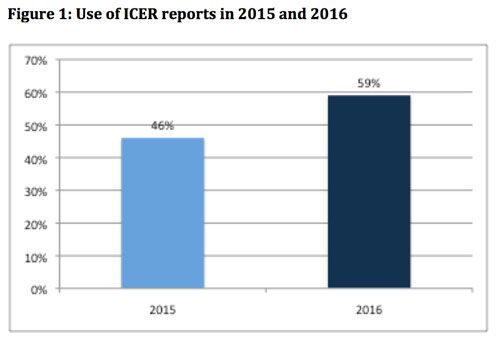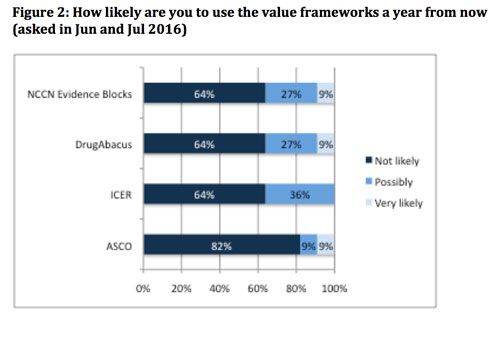Value Frameworks in the US: Not an Echo Chamber
In the second of her articles on US value assessment, Leela Barham reviews the emergence of multiple frameworks and looks at their potential impact.
Prompted by the ever more vocal concerns about the price and costs of drugs in the US – and globally – various groups have developed value frameworks (also known as value assessment frameworks) to consider the benefits and costs of new drugs, mostly in cancer, but across other therapies too. These are generating much debate but are they being listened to, or are they just talking amongst themselves?
Emergence of multiple value frameworks in the US
Since 2015 a number of value frameworks have emerged in the US. They include value frameworks from the American College of Cardiology and the American Heart Association (ACC-AHA) value framework for cardiovascular disease. For cancer there’s the American Society of Clinical Oncology (ASCO) Value Framework, the Drug Abacus from the Memorial Sloan-Kettering Cancer Centres, and the National Comprehensive Cancer Network’s (NCCN’s) Evidence blocks. The Institute for Clinical Effectiveness Review (ICER) value assessment framework can be applied to any therapy area. ICER is however looking at orphan drugs, and exploring differences that might be needed in that context. Avalere and Faster Cures are also working on their own Patient Perspective Value Framework Initiative.
Different audiences, but value assessments open to all
The value frameworks have been set up with different audiences in mind. The ACC-AHA value framework, ASCO value framework and NCCN’s Evidence Blocks all aim to inform decisions made by physicians and patients. The DrugAbacus and ICERs value frameworks aim to inform not only physicians and patients but payers and policy-makers too.
That said though, once the value framework – and the value assessments that are the output of them – are "out there", especially when hosted on websites with no limits on access, they can be picked up and used by anyone who can read English and has internet access. Even the language barrier is lower these days too, given tools like Google Translate. So that means that value frameworks and their outputs could be used far and wide, and not necessarily in the ways that their designers expected.
Evidence of use of the resulting value assessments
It’s difficult to know the reach and use of value assessments being produced from the application of the still new US value frameworks. Not all have resulted in tangible reports – yet – as is the case for the ACC-AHA - and for others there are limited examples of their use. Despite it being early days there are some indications about the potential and real impact on pricing, reimbursement and access decisions, mostly informed by surveys of payers. So what have they been saying?
One of the few surveys to be re-run comes from Dymaxium. They surveyed decision-makers in managed care, pharmacy benefit management (PBM) organizations and hospitals in September-October 2015 and then again in May 2016 on use of ICER reports. That suggests that over time more payers are using ICER reports, although not all are (Figure 1).
Source: Data from Lising, Drummond, Barry and Augustovski (2017), Payers Use of Independent Reports in Decision Making: Will There Be an ICER Effect?, Value & Outcomes Spotlight. N = 100 in 2015, N = 99 in 2016

In June and July 2016, Avalere surveyed 11 health plans in the US to find out how likely they were to use 4 of the value frameworks in the next year (ASCO, ICER, DrugAbacus and NCCN’s Evidence Blocks). Their results suggested that most weren’t planning to use the value frameworks, at least for the near-term (Figure 2).
Jeremy Schafer and colleagues also surveyed US health plans, in August 2016, and with 28 respondents. That survey suggested that the majority (71%) were using at least one value framework.
Navigant also surveyed 27 US payers in 2016. They found that current and intended use of value frameworks (ACA-AHA, ASCO, Drug Abacus, ICER, NCCN Evidence Blocks) varies; from informally referenced by individuals out of curiosity or personal interest to being referenced in negotiations with companies and a host of other uses. The question was phrased about current and anticipated future use, over the next five years, so it’s had to know how far these intentions have translated into concrete actions.
Source: Data from Avalere N = 11

Xcenda surveyed US payers in
November 2016
, with 55 responding. Just as Dymaxium did, they focus on use of ICER reports. Their results suggest that ICER reports are influencing decisions just under half the time: 5% of respondents reported that ICER recommendations often influence decisions, 44% occasionally although 51% said that ICER recommendations weren’t influencing decisions. The influence of ICER is greatest when it comes to comparative clinical effectiveness (Figure 3).
The Xcenda survey also has the potential to benchmark how ICER makes progress on the limitations seen by payers in using their reports (Figure 4), if their survey is repeated. Timeliness seems to be key to making ICER final reports more useful to payers.
Source: Data from Xcenda. Note: Based on 27 payers who had indicated that ICER recommendations had influenced coverage decisions in their organizations.

The surveys aren’t all consistent, but they do suggest that there is a real appetite for value frameworks and their outputs amongst US payers (although all those doing the surveys have an interest in promoting the influence of value frameworks; they all provide services that can help companies respond to the need to demonstrate the value of their products).
Stronger evidence for use amongst payers is their formal collaboration with the agencies doing the value assessments. ICER just announced (June 27, 2017) that the Department of Veterans Affairs’ Pharmacy Benefits Managed Services Office and ICER will be working together. ICER will be helping the PBM to integrate ICER reports into the formulary, not only that but develop options for how to use ICER’s value based price benchmarks too.
Even if not used by all US payers now, value frameworks and their outputs may be used more often than not in the future. This is especially the case if payers engage in the refining of these frameworks and developers respond to their needs. Some payers seem to be engaging with ICER, being just some of those who responded to the public consultation run by ICER to update their value assessment framework during 2016 and into 2017.
Source: Data from Xcenda. N = 55 and each respondent could choose up to 3 responses.

The hidden use and long-term impact of value frameworks
Surveys of payers can provide an insight but the real influence of value frameworks and their outputs on price, reimbursement and access decisions is not just their impact on payers but on clinicians and patients too as they have some power to push back or endorse. Plus the impact of reports and recommendations derived from the US may well be felt in other countries; just as reports from agencies such as the National Institute for Health and Care Excellence (NICE) and the Scottish Medicines Consortium (SMC) are used outside of the UK, US reports can be useful to those outside the US.
Using reports from elsewhere needs appropriate translation to the local context, as corners should not be cut when it comes to applying evidence and findings from elsewhere, as tempting as that is. Although in reality, the degree to which findings are really "contextualized" will be limited and reflect local skills and capabilities. That’s why it matters so much to get the value framework right in the first place, and adds flames to the fire in the vocal debates on the merits or otherwise of the US value frameworks. They are going through what agencies like NICE and others have gone through over the last, almost two, decades.
Even established agencies like NICE still generate heated debate, and make changes as they go. The latest changes at NICE – in conjunction with the payer organisation, NHS England – could be subject to a legal challenge from the UK industry association, the Association of the British Pharmaceutical Industry (ABPI). ABPI have applied the first stage to see if they can take forward what is known as a Judicial Review (JR). It’s proving unpopular to add in a budget impact test, something that also features in ICERs value framework. This signals that debate and refinement of US value frameworks will at the very least be an intense process too.
There is also an argument that value frameworks will also alter how companies approach their internal decision-making and how they build evidence, after all far better to anticipate the needs of the customers than back-fill later. Especially big US customers. Its harder to make the case to change to meet the needs of much smaller markets and less influential agencies. They may also provide stronger signals over time on just what the new drugs that will be seen as valuable will be and may have a – subtle – influence on R&D decisions.
Changing R&D decision-making, even if marginal, may especially be the case if there is a growing consensus on what is most valuable, if not globally but across the pond with Europe where there are already great efforts to collaborate on Health Technology Assessment (HTA). Complete agreement may never happen on value frameworks, or at least seems far off, but on some issues – such as the importance of the patient perspective – there seems to be a consensus, on the principle if not the practice.
The full and true impact of value frameworks will therefore be very difficult to measure, but have the potential to be transformative in the long term.
Navigating Distrust: Pharma in the Age of Social Media
February 18th 2025Ian Baer, Founder and CEO of Sooth, discusses how the growing distrust in social media will impact industry marketing strategies and the relationships between pharmaceutical companies and the patients they aim to serve. He also explains dark social, how to combat misinformation, closing the trust gap, and more.
FDA Approves Celltrion’s Xolair Biosimilar Omlyclo for Multiple Indications
March 10th 2025Omlyclo, a biosimilar to Xolair, is indicated for the treatment of moderate to severe persistent asthma, chronic rhinosinusitis with nasal polyps, immunoglobulin E-mediated food allergies, and chronic spontaneous urticaria.